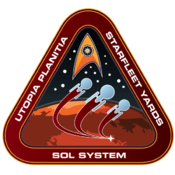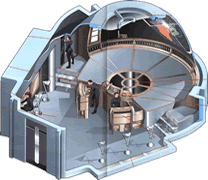Akira class/Science Labs
| Utopia Planitia Fleet Yards |
|---|
|
CRUISERS
Science LabsThere are twenty science labs on the Akira Class; five labs are on deck 4 - adjacent to Sickbay, 10 labs are on deck 5, 2 microlabs on deck 14 and 3 multi function labs on deck 6. The 5 labs on deck 4 are bio-chem-physics labs that can also be reconfigured for Medical labs. The 10 labs on deck 5 are a mixed batch; three are bio-chem-physics, one is an XT (extra-terrestrial) analysis lab, and one a eugenic lab. The two smaller labs on deck 14 are astrophysics/astrometrics and stellar cartography labs. The final 3 on deck 6 are multi-functional labs that can be equipped for various experiments. On most Akira-class starships, the Chief Science Officer's Office is located on Deck 14 close to Stellar Cartography.
Stellar CartographyOne stellar cartography bay is located on deck 14, with direct EPS power feed from engineering. All information is directed to the bridge and can be displayed on any console or the main viewscreen. The Chief Science Officer's office is located next to the Stellar Cartography.
ProbesA probe is a device that contains a number of general purpose or mission specific sensors and can be launched from a starship for closer examination of objects in space. There are nine different classes of probes, which vary in sensor types, power, and performance ratings. The spacecraft frame of a probe consists of molded duranium-tritanium and pressure-bonded lufium boronate, with sensor windows of triple layered transparent aluminum. With a warhead attached, a probe becomes a photon torpedo. The standard equipment of all nine types of probes are instruments to detect and analyze all normal EM and subspace bands, organic and inorganic chemical compounds, atmospheric constituents, and mechanical force properties. All nine types are capable of surviving a powered atmospheric entry, but only three are specially designed for aerial maneuvering and soft landing. These ones can also be used for spatial burying. Many probes can be real-time controlled and piloted from a starship to investigate an environment dangerous hostile or otherwise inaccessible for an away-team. |
- Black-and-white ship illustrations by Tim Davies unless otherwise noted. Used with permission. All other images are copyright to their respective owners.
- Black-and-white ship illustrations by Tim Davies unless otherwise noted. Used with permission. All other images are copyright to their respective owners.
| REV SD 239701.21 |
|---|



